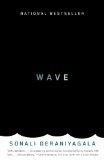Summary | Excerpt | Reviews | Beyond the Book | Read-Alikes | Genres & Themes | Author Bio

This article relates to Wave
Wave is not a linear account of the tsunami, and because the author's stark focus is internal, the disaster and events in the months and years that followed, are often hazy. Because of this, it's worth taking a look at the magnitude and nature of the tsunami the author survived.
A tsunami is a series of giant waves caused either by an earthquake or a volcanic eruption under the sea. Either of these phenomena leads to water displacement which in turn churns large quantities of water into massive waves. A tsunami is not just one wave but a series of walls of water minutes or even up to an hour apart.
The 2004 tsunami, which caused widespread destruction, was triggered by a massive earthquake of magnitude 9.0 just off the coast of the Indonesian island of Sumatra. The two tectonic plates which triggered the earthquake were the Burma and India plates. According to the U.S. Geological Survey, this earthquake released the energy of 23,000 Hiroshima-type atomic bombs. By the end of the day (December 26), more than 150,000 people were dead or missing across 11 countries and millions more were rendered homeless. The tsunami is estimated to have taken close to 230,000 lives. Indonesia, especially the region of Aceh, was the hardest hit with an estimated toll of 170,000.
 The author, a native of Sri Lanka, was vacationing there, when the tsunami hit. According to a United Nations University Institute for Environment and Human Security report, it took two hours for the wave to hit the coast of Sri Lanka, where it reached a height of about 20 feet. In 2004, Sri Lanka had no tsunami warning system in place and, "...had no living memory of a tsunami," arriving to a "population completely unaware and unprepared." The tsunami affected 57.4% of Sri Lanka's total population, leaving, "35,000 dead and over a million displaced, some 150,000 without jobs, over 100,000 houses destroyed and a reconstruction bill of over $3 billion."
The author, a native of Sri Lanka, was vacationing there, when the tsunami hit. According to a United Nations University Institute for Environment and Human Security report, it took two hours for the wave to hit the coast of Sri Lanka, where it reached a height of about 20 feet. In 2004, Sri Lanka had no tsunami warning system in place and, "...had no living memory of a tsunami," arriving to a "population completely unaware and unprepared." The tsunami affected 57.4% of Sri Lanka's total population, leaving, "35,000 dead and over a million displaced, some 150,000 without jobs, over 100,000 houses destroyed and a reconstruction bill of over $3 billion."
Recovery efforts in the country were complicated by an ongoing civil war and clashing interests from competing ethnic groups. Nevertheless Sri Lanka is coming back and the country is enjoying a resurgence in tourism.
Tsunami map picture from Worldatlas.com
Filed under People, Eras & Events
![]() This "beyond the book article" relates to Wave. It originally ran in May 2013 and has been updated for the
January 2014 paperback edition.
Go to magazine.
This "beyond the book article" relates to Wave. It originally ran in May 2013 and has been updated for the
January 2014 paperback edition.
Go to magazine.
Your guide toexceptional books
BookBrowse seeks out and recommends the best in contemporary fiction and nonfiction—books that not only engage and entertain but also deepen our understanding of ourselves and the world around us.